| Pages:
1
..
34
35
36
37
38
..
48 |
quicksilver
International Hazard
    
Posts: 1820
Registered: 7-9-2005
Location: Inches from the keyboard....
Member Is Offline
Mood: ~-=SWINGS=-~
|
|
Dann2:
Again, thanks - your suggestions have consistently been valuable and appreciated.
|
|
|
dann2
International Hazard
    
Posts: 1523
Registered: 31-1-2007
Member Is Offline
Mood: No Mood
|
|
Hello,
Just when you though the subject of Cathodes was at an end........
Link here:
http://www.faqs.org/patents/app/20080230381
which describes using Phosphates in conjunction with Fe-Mo alloy coated Cathodes for to buffer Chlorate electrolyte and stop Cathodic reduction thus
eliminating Chromates.
ONLY HARD CORE, 'GREEN' CELL RUNNING FOLKS CAN GET INTO THIS STUFF 
(I will be giving it a miss)
Dann2
|
|
|
ninefingers
Harmless

Posts: 13
Registered: 16-2-2010
Location: Cactus Country Tucson AZ
Member Is Offline
Mood: Vulcan don't have moods
|
|
Quote: Originally posted by dann2  | Quote: Originally posted by ninefingers  | This is probably old hat to you guys, but:
Ti anodes seem to corrode right at where they touch the air. That DMV can be painted and they will then work well. Even the copper rods I use to
hold my anode and cathode get corroded, so I paint everything above the water level except exactly where I need electrical contact. That gets graphite
grease. |
| Quote: | | Can you explain what your "Ti Anodes" consist off? |
They are pure titanium . Right where air contacts them they burn (DMZ, not DMV, sorry.) I'd still like to try gold filled chains before investing in
Pt. I got ripped of by a Pt scam on eBay; there went my budget.
|
|
|
|
JohnWW
International Hazard
    
Posts: 2849
Registered: 27-7-2004
Location: New Zealand
Member Is Offline
Mood: No Mood
|
|
Quote: Originally posted by dann2  |
They are pure titanium . Right where air contacts them they burn (DMZ, not DMV, sorry.) I'd still like to try gold filled chains before investing in
Pt. I got ripped of by a Pt scam on eBay; there went my budget.
|
Can you please tell us how the Pt $cam on eBay was operated? Who was the culprit?
|
|
|
Gamal
Harmless

Posts: 24
Registered: 6-11-2005
Location: Sweden
Member Is Offline
Mood: No Mood
|
|
Quote: Originally posted by dann2  | Hello,
Just when you though the subject of Cathodes was at an end........
Link here:
http://www.faqs.org/patents/app/20080230381
which describes using Phosphates in conjunction with Fe-Mo alloy coated Cathodes for to buffer Chlorate electrolyte and stop Cathodic reduction thus
eliminating Chromates.
ONLY HARD CORE, 'GREEN' CELL RUNNING FOLKS CAN GET INTO THIS STUFF 
(I will be giving it a miss)
Dann2 |
Interesting reading!
Looks like they use mmo-anodes with chromates in the electrolyte. I though that wasn't possible. Have I missed something?
If I get it right, they get a ph stabilized cell only by the addition of phosfate to the cell.
"The hypochlorite concentration was quickly stabilised at a value of 0.06 mol/l for the cell with activated cathodes, and of 0.07 mol/l for the cell
with non-activated cathodes."
Maybe I'm mixing things up here.
/Gamal
|
|
|
Gamal
Harmless

Posts: 24
Registered: 6-11-2005
Location: Sweden
Member Is Offline
Mood: No Mood
|
|
Is this thread dead or what?
This is my favourite thred for now, as I'm planning my cell configuration.
I hope there will be some more interest in this topic in the future.
I'm thinking about using an aquarium as the cell. Do you think it's a good idea?
Does the silicon seals withstand the cell environment?
/Gamal
[Edited on 8-6-2010 by Gamal]
|
|
|
hashashan
Hazard to Others
  
Posts: 255
Registered: 10-10-2006
Member Is Offline
Mood: No Mood
|
|
I noticed that in quite a short time all the adhesives degrade therefore my recommendation is to use a plain plastic container .. you can get those in
quite large sizes so that it would fit you.
|
|
|
hissingnoise
International Hazard
    
Posts: 3940
Registered: 26-12-2002
Member Is Offline
Mood: Pulverulescent!
|
|
I'd go for glass every time - a large glass jar; doesn't degrade or opacify over time.
|
|
|
dann2
International Hazard
    
Posts: 1523
Registered: 31-1-2007
Member Is Offline
Mood: No Mood
|
|
Na Perchlorate
Hello Folks,
It's been a while. I have have silicon sealer at the top of my cells and it does not seem to have degraded but it was NOT holding in any liqued. Just
a seal to stop gases from getting out round the rim.
If you just a want a small (2 liter cell) you can cut a glass 'demijohn' using a glass cutter and a hot wire to crack it.
@Gamal. It is OK to use Chromated with MMO. Lead Dioxide does not like the stuff as it reduces CE.
Some Sodium Perchlorate 'cakes' attached for you pleasure!
The stuff is just about impossible to crystallize. I can't imagine how they do it in industry in a normal crystallizer (they probably do not). I
heated the solution untill it just about all evaporated away and then drained off the small amount of solution that was left on cooling from the
solid. I then vacuum filtered the stuff (Buchner funnel) and obtained the pictured cakes (wet hydrates of some description). I put the these cakes in
an oven at 120 degrees C and they turned to pools of liquid. They dried eventually and the cakes were found to contain 22% water.
Getting around to trying out a Bi doped Tin Oxide Anode for Perchlorate. Don't hold your breath.
Dann2
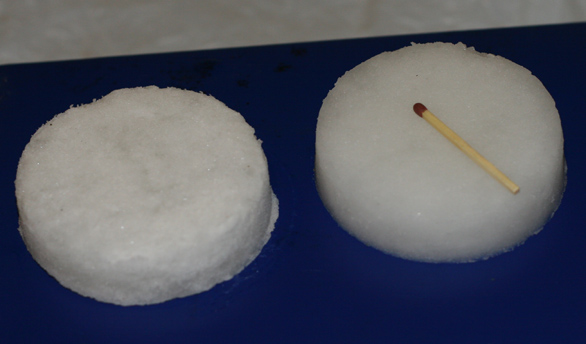
|
|
|
mnick12
Hazard to Others
  
Posts: 404
Registered: 30-12-2009
Location: In the lab w/ Dr. Evil
Member Is Offline
Mood: devious
|
|
Good job on the perchlorate, what was your anode material?
I have just been getting into chlorate synthesis and it is very neet. I am using a cobalt oxide/ nickel oxide with V2O5 on titanium for my anode and a
iron cathode. I have had 3 cells so far two potassium chlorate and one sodium chlorate. The cells were powered by a cpu power supply. I have not
weighed everything, but I would guess I have 700gr of KClO3 and mabe 300gr of NaClO3. The only trouble I have had is with the cathode corroding so I
had to add about 200mg of CrO3, which seemed to stop it. The anode has not correded at all, so I hope some time try it in a perchlorate cell. Cool
stuff though.
I have been wondering what do most of you do with your chlorates and perchlorates? My pyro days are over so I have been using my chlorate as an
oxidizer for some organic chemistry rections, like oxidizing hydroquinone to benzoquinone. But what do you guys use it for?
thanks
|
|
|
12AX7
Post Harlot
    
Posts: 4803
Registered: 8-3-2005
Location: oscillating
Member Is Offline
Mood: informative
|
|
I have a bag (a few pounds) of what I expect is crude NaClO4. As I recall, the bag was leaky and humidity was getting in, causing it to turn to mush
again. Last I checked, I double bagged it...
The last thing I used chlorate for was speeding up the etching of circuit boards. I regularly use CuCl2 + HCl and it goes several times faster with
chlorate. Be careful not to add too much or you'll gas yourself!
Tim
|
|
|
Gamal
Harmless

Posts: 24
Registered: 6-11-2005
Location: Sweden
Member Is Offline
Mood: No Mood
|
|
@12AX7
That's interesting!
Do You use only chlorate or a mix of CuCl2 + chlorate?
What concentrations do you use?
It's nice to see this thread coming to live again!
/Gamal
|
|
|
12AX7
Post Harlot
    
Posts: 4803
Registered: 8-3-2005
Location: oscillating
Member Is Offline
Mood: informative
|
|
I use a solution of bright green CuCl2 + HCl. There is probably a considerable amount of sodium in solution by now. Heat to about 50C, add NaClO3
periodically. More than a large pinch will result in chlorine fumes, which needless to say is unpleasant to the operator.
Tim
|
|
|
white rabbit
Harmless

Posts: 33
Registered: 29-11-2009
Member Is Offline
Mood: Groovy
|
|
I have found that the platinum clad niobium electrodes from Anomet work exceptionally well. After well over a 1000 hours it appears unchanged. I use
304L stainless steel for the cathode and a rewound Mot for the supply. I run 25 amps at 6.2 volts measured at the electrodes. A run of 2.5 lbs KCl to
chlorate takes 6 days to complete. 2.5lbs of NaCl to NaClO4 takes 180 hours minimum and complete conversion takes almost twice that. Solution temp
runs a steady 85*C. The stainless cathode needs to be cleaned before every run. I do not adjust pH or run any chromates.
Here is a pic of the anodes.
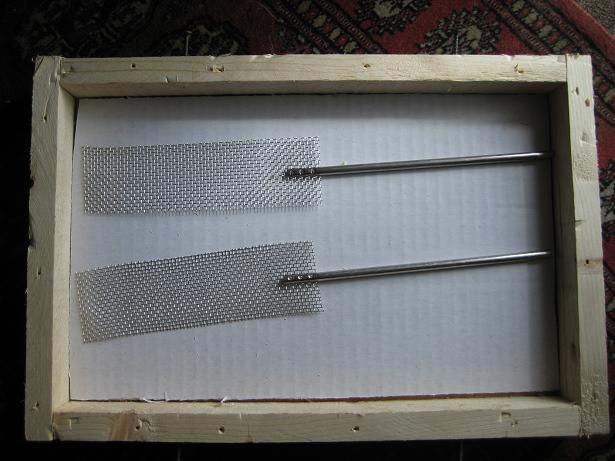
Here is the stainless cathode with the section not in solution protected with heat shrink tubing
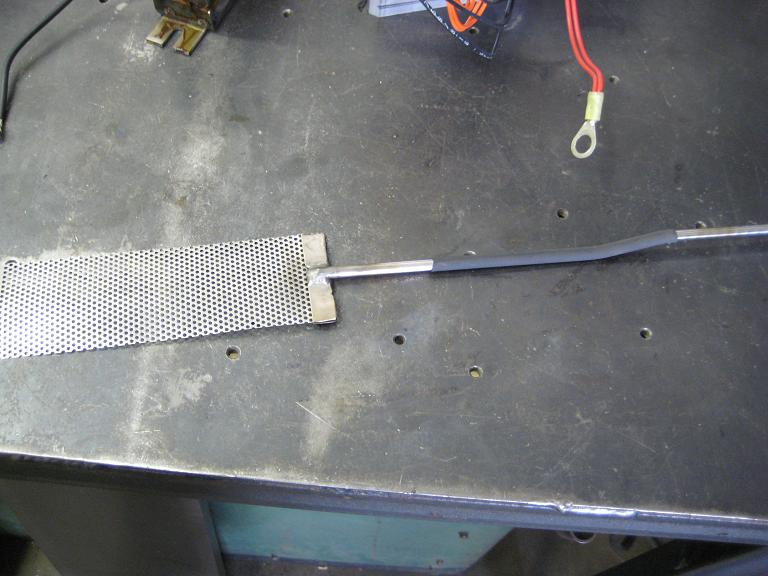
Here, the direct conversion of KCl, is almost complete
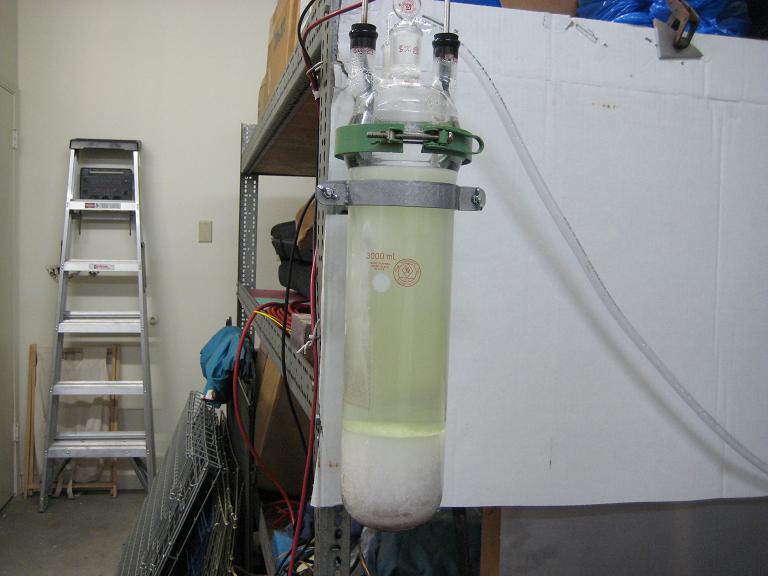
Here is the power supply. A rewound microwave transformer with a Pi filter. The secondary windings are 10 gauge and center tapped to use 2 diodes.
There is 44,000Mfd on one side of the inductor and 85,000 on the other. Ripple is less than 1/10 volt at load.
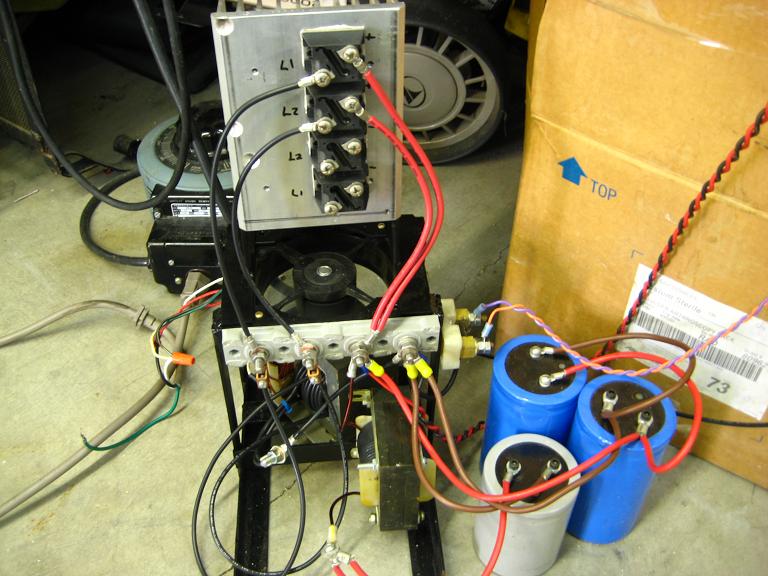
980 grams KClO4 (1/2 of one run)
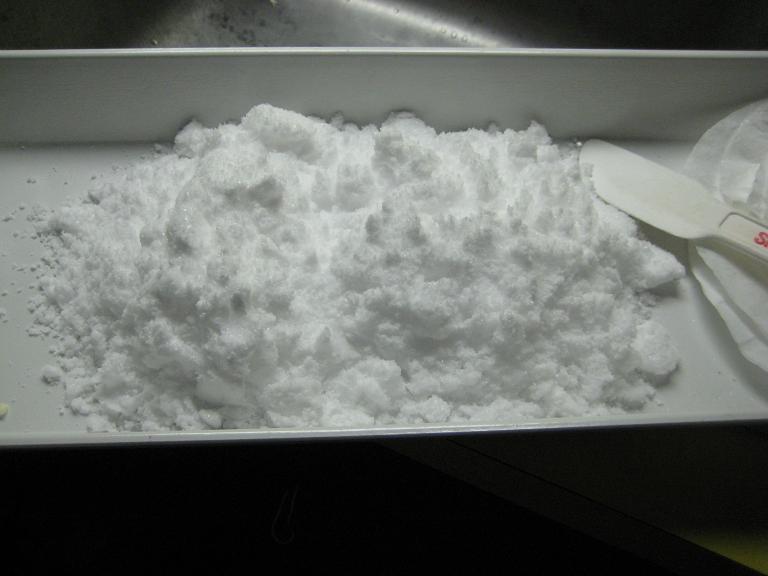
|
|
|
Alexein
Harmless

Posts: 35
Registered: 14-7-2007
Member Is Offline
Mood: Metastable
|
|
Holy smokes!
How much did those anodes cost you? and do they sell to individuals?
|
|
|
hissingnoise
International Hazard
    
Posts: 3940
Registered: 26-12-2002
Member Is Offline
Mood: Pulverulescent!
|
|
Quote: Originally posted by white rabbit  | I have found that the platinum clad niobium electrodes from Anomet work exceptionally well. After well over a 1000 hours it appears unchanged.
|
Nice work white rabbit. . .
The Pt plating on the anode will erode completely, though, given time.
A way around this is to use a second Pt-plated electrode as a cathode.
Pt lost from the anode will plate onto the cathode and this can be replated back by reversing the polarity of the cell every few hundred hours or so.
As it is, Pt is plating onto the ST cathode and is lost when cleaning.
I know it means double expense, but electrode life can be prolonged almost indefinitely. . .
|
|
|
white rabbit
Harmless

Posts: 33
Registered: 29-11-2009
Member Is Offline
Mood: Groovy
|
|
@ Alexein/The electrodes were very reasonable, I think, at about $135 each including the shipping. I bought 4 for $540. They save a great deal of time
on filtering and washing.
Thanks,Hissingnoise
It seems if the anodes are going to eventually corrode I will probably be long dead by then. There is absolutely no sign of wear as of now. ( I've
run of over 20 lbs so far)
I have tried the platinum cathode and I can tell you that it is a very bad thing to do. I completely destroyed, (turned to powder), one of the 4
electrodes I bought, which leads me to believe that your idea of the platinum plating onto the cathode in normal operation is incorrect. It seems
the plating goes from negative to positive, this is why, it seems, my platinum cathode completely dissolved in about 150 hours. Have you noticed the
extremely vigorous action at the cathode and almost no activity at the anode during the normal electrolysis? When I have finished a run of
perchlorate, the cathode looks extremely corroded and the platinum looks just like new. I think the best combination is a Ti cathode and platinum
anode. (the anodes are actually platinum clad niobium)
Btw,I have 6 videos on youtube of these electrolysis. Just search "ytmachx"
|
|
|
white rabbit
Harmless

Posts: 33
Registered: 29-11-2009
Member Is Offline
Mood: Groovy
|
|
Here is something that you probably don't come across too often.It appears to be a sodium chlorate crystal that I found in the bottom of my
electrolyte one day.
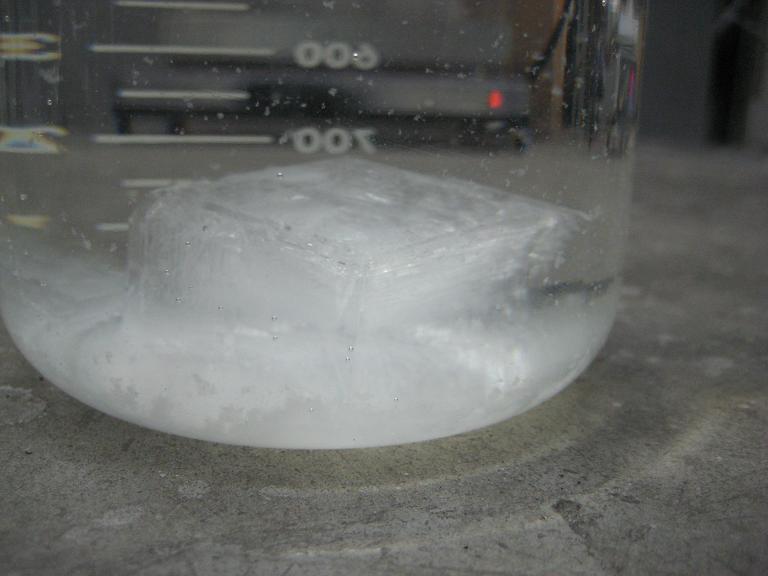
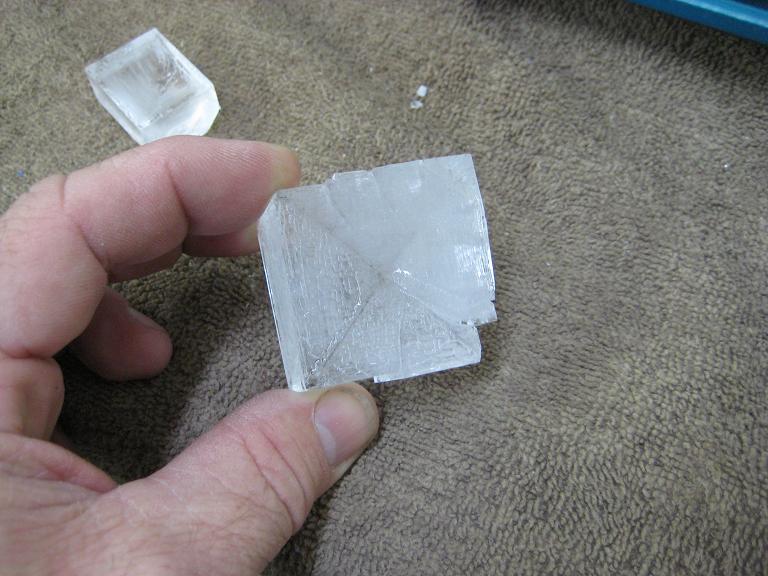
[file]10743[/file]
|
|
|
12AX7
Post Harlot
    
Posts: 4803
Registered: 8-3-2005
Location: oscillating
Member Is Offline
Mood: informative
|
|
Strange, I get differently shaped crystals, never cubic.
Tim
|
|
|
hissingnoise
International Hazard
    
Posts: 3940
Registered: 26-12-2002
Member Is Offline
Mood: Pulverulescent!
|
|
Quote: Originally posted by white rabbit  |
I have tried the platinum cathode and I can tell you that it is a very bad thing to do. I completely destroyed, (turned to powder), one of the 4
electrodes I bought, which leads me to believe that your idea of the platinum plating onto the cathode in normal operation is incorrect. It seems
the plating goes from negative to positive, this is why, it seems, my platinum cathode completely dissolved in about 150 hours. Have you noticed the
extremely vigorous action at the cathode and almost no activity at the anode during the normal electrolysis? |
For someone producing perchlorate by the pound you seem to know little about electrolysis. . .
|
|
|
12AX7
Post Harlot
    
Posts: 4803
Registered: 8-3-2005
Location: oscillating
Member Is Offline
Mood: informative
|
|
I would think the large quantity of hydrogen would have a noticable effect on the cathode. Certainly it isn't plating across, and I find the theory
suspect, that platinum will plate reversibly between anode and cathode. Foaming hydrogen is not conducive to bright, dense deposits.
Tim
|
|
|
hissingnoise
International Hazard
    
Posts: 3940
Registered: 26-12-2002
Member Is Offline
Mood: Pulverulescent!
|
|
| Quote: | | Foaming hydrogen is not conducive to bright, dense deposits. |
That would certainly be true in normal plating processes, but in this case the loss from the anode is really very small, so small that the rate of
plating on the cathode would be so slow that effects from the evolution of H2 should be negligible. . .
|
|
|
white rabbit
Harmless

Posts: 33
Registered: 29-11-2009
Member Is Offline
Mood: Groovy
|
|
Quote: Originally posted by hissingnoise  | Quote: Originally posted by white rabbit  |
I have tried the platinum cathode and I can tell you that it is a very bad thing to do. I completely destroyed, (turned to powder), one of the 4
electrodes I bought, which leads me to believe that your idea of the platinum plating onto the cathode in normal operation is incorrect. It seems
the plating goes from negative to positive, this is why, it seems, my platinum cathode completely dissolved in about 150 hours. Have you noticed the
extremely vigorous action at the cathode and almost no activity at the anode during the normal electrolysis? |
For someone producing perchlorate by the pound you seem to know little about electrolysis. . .
|
As I have already stated, and proved, your theory is incorrect.
You may have noticed, I do the work and then share the information, not just type theories. I may not have book smarts, but I have experience. I
learned long ago, doing is better than talking and experience is a better teacher.
I've seen Tim's work and for that I have a great deal of respect for him.
Have you got anything to put on the table, or are you just going sit there and wiggle your fingers?
|
|
|
avi66
Harmless

Posts: 46
Registered: 8-4-2010
Member Is Offline
Mood: No Mood
|
|
if i run my sodium chloride cell with access sodium chloride on the bottom ... the access sodium chlorate will form pure crystal on the bottom in some
stage?
i read that the crystallization of chlorate is selective ... so the crystals which i collect from the bottom of the cell are pure naclo3 which only
need little surface purification?
if i use mno2 anode with non-controlled ph chlorate cell... i will not get hcl in the cell ... i get naoh ... so the anode corrosion will form only
insoluble black mno2 powder?
|
|
|
hissingnoise
International Hazard
    
Posts: 3940
Registered: 26-12-2002
Member Is Offline
Mood: Pulverulescent!
|
|
What?
My theory that metals from an electrolyte or anode plate onto the cathode of an electrolytic cell. . .
It's only the fundamental process in electrolysis - not a "theory"!
And you've now, already stated and proven that it is not correct?
|
|
|
| Pages:
1
..
34
35
36
37
38
..
48 |